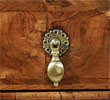Brass mounts were used on furniture from the 17th century onwards – the metal was popular because it had a good colour which enhanced the surrounding wood; it was also relatively soft and easy to work – and could be reproduced quickly and easily by casting.
 The earliest examples were the pear-drop: a bulbous drop fitted to a circular back plate. These were typically used during the William and Mary period, on mostly heavy, moulded oak pieces. With the advent of the walnut period, these and similar strap drops continued to be used, but also introduced was a type of handle used throughout the 18th century: the loop handle with two fastenings.
The earliest examples were the pear-drop: a bulbous drop fitted to a circular back plate. These were typically used during the William and Mary period, on mostly heavy, moulded oak pieces. With the advent of the walnut period, these and similar strap drops continued to be used, but also introduced was a type of handle used throughout the 18th century: the loop handle with two fastenings.
 The first of these had a shaped back plate with a chased, or engraved, decoration on it. As the century progressed, and the walnut and early mahogany furniture grew more sophisticated, the shaping of these back plates became more elaborate, with scrollwork and arabesques. The centre was often fretted out to echo the design, and matched with equally elaborate ‘escutcheons’, or key hole plates.
The first of these had a shaped back plate with a chased, or engraved, decoration on it. As the century progressed, and the walnut and early mahogany furniture grew more sophisticated, the shaping of these back plates became more elaborate, with scrollwork and arabesques. The centre was often fretted out to echo the design, and matched with equally elaborate ‘escutcheons’, or key hole plates.
 In about 1750 a new, simpler type supplanted these: retaining the loop or ‘swan neck’ handle, the single back plate disappeared to be replaced by two small circular plates. The focus became less on the handles, more on the figure of the wood during the classic Georgian period. French influence began to be apparent around this time too, such as the flamboyant Rococo mounts of the Chippendale style, and these were often gilded to protect the metal from tarnishing.
In about 1750 a new, simpler type supplanted these: retaining the loop or ‘swan neck’ handle, the single back plate disappeared to be replaced by two small circular plates. The focus became less on the handles, more on the figure of the wood during the classic Georgian period. French influence began to be apparent around this time too, such as the flamboyant Rococo mounts of the Chippendale style, and these were often gilded to protect the metal from tarnishing.
 The development of sheet brass which could be stamped or pressed intoshape saw the introduction, in the 1780s, of the first metal knobs, with pressed brass fronts, decorated with fashionable motifs of the day, such as thistles. Throughout the Sheraton period brass knobs became smaller and more elegant, before they were superseded by wooden ones at the start of the 19th century.
The development of sheet brass which could be stamped or pressed intoshape saw the introduction, in the 1780s, of the first metal knobs, with pressed brass fronts, decorated with fashionable motifs of the day, such as thistles. Throughout the Sheraton period brass knobs became smaller and more elegant, before they were superseded by wooden ones at the start of the 19th century.
 The continuous back-plate also re-emerged in the 1780s, pressed most commonly into an oval or round shape, sometimes in geometric form – ushering in the Regency period with its exotic designs. ‘Lion’s Mask’ handles were typical – a cast lions head, with a ring in its mouth as the handle.
The continuous back-plate also re-emerged in the 1780s, pressed most commonly into an oval or round shape, sometimes in geometric form – ushering in the Regency period with its exotic designs. ‘Lion’s Mask’ handles were typical – a cast lions head, with a ring in its mouth as the handle.